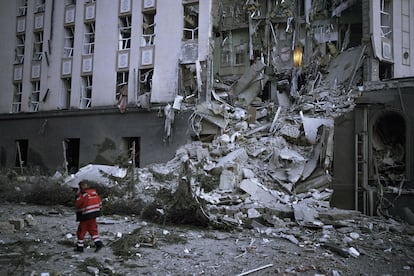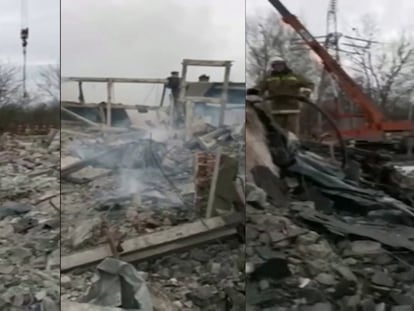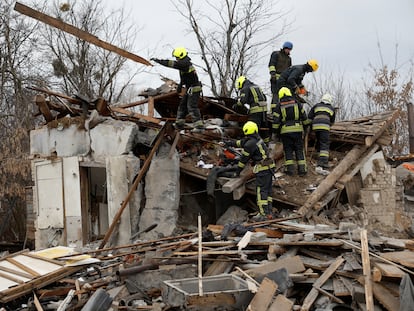Ukraine alters air defense strategy to counter waves of suicide drone attacks
Kyiv is using less expensive mobile units – rather than surface-to-air missile systems – in order to stop the bombardment by Russia’s unmanned devices


The Kyiv sky turned into a terrifying spectacle in the early hours of January 1 and 2. Low-altitude explosions, searchlights in the darkness, the hiss of missiles and the flash of large-caliber bullets confirmed that Russian forces would continue their attack on Ukraine’s civilians in 2023.
According to the Ukrainian Air Force, more than 80 Shahed drone bombs were dropped by Russia on the first nights of 2023. However, only two managed to hit their targets: a power substation and a group of homes were severely damaged.
Before this bombardment, on the afternoon of December 31, a dozen cruise missiles were aimed at the capital – but only three managed to hit the city, as the Ukrainian air defense systems are very effective. Equipped with NATO-provided weapons, such as S-300 surface-to-air missile systems (along with outdated Soviet models), Kyiv’s defensive ring is formidable.
According to the Ukrainian authorities, on average, 80% of Russian drones are shot down, while about 70% of missiles are intercepted. Of course, a perfect record is impossible, as Russia tends to attack with waves of multiple projectiles, meaning that at least one has the possibility of making it past all defensive barriers.
Russia is depending heavily on Iranian-made Shahed drones. Each unmanned weapon costs between $20,000 and $50,000 – well below the cost of the cruise missiles that Russian forces fire off from their own territory or the Black Sea. The average Russian cruise missile can cost anywhere from $250,000 to a $1 million, while enormous domestic manufacturing capacity is required to maintain supply and Western sanctions have stymied production. Shahed drones, on the other hand, are assembled by Iran much more quickly.
The Kremlin’s bombardments deep into Ukrainian territory have been recurring since the spring of 2022, although Russian ground troops have been forced to retreat. In a desperate attempt to reverse his failing offensive, Putin turned to Iranian drone bombs in October, eager to punish civilians and cripple energy networks across Ukraine.
Russian cruise missiles – such as the Kh-101 and Kh-55 – fly close to the speed of sound and have a maneuverability that makes them harder to shoot down. But the drones – in addition to being cheaper – are a key part of Putin’s plan to deplete Ukraine’s arsenal of surface-to-air missiles, which are supplied by NATO. President Volodymyr Zelenskiy confirmed this strategy in a speech this week.
Kyiv has expended most of its diplomatic energy over the past six months in a lobbying attempt to obtain surface-to-air missile defense systems from the United States and other NATO countries. There are currently German, Spanish and American-made systems operating in Ukraine. In the coming weeks, a Patriot air defense system will be sent to Kyiv by the Biden administration, with more technology to come from France and Italy.
The Ukrainian air defense structure principally relies on radar and anti-aircraft batteries to detect and shoot down Russian missiles. However, intercepting drones can be a challenge for more outdated technology, as they fly at a lower altitude to avoid being detected by radar. Yuri Ihnat – a spokesman for the Ukrainian Air Force – and Captain Viktor Tregubov both confirmed this to EL PAÍS. They explain that communications experts have begun to use auditory detection to track Shahed drones, due to the unusual noise that they make. Ukrainian forces are also constantly receiving tips from NATO intelligence services, which sometimes alert them when bombers take off from Russian territory.
In recent months, Ukrainian forces have been utilizing mobile units. The soldiers who travel with them carry portable rocket launchers and drive anti-aircraft vehicles, which are equipped with automatic cannons.
Military analysts recommend that Ukraine strengthens these mobile defense units – which don’t rely on surface-to-air missiles – because of the cost of ammunition. In a study by the Ukrainian University of Environmental Sciences – published in September by the Political Science and Security Studies Journal – it was noted that the cheapest surface-to-air missile costs at least 25 times more than a Shahed drone. Meanwhile, a portable rocket launcher only costs about twice as much.
In a report from December 2022, experts from the US-based Center for Strategic and International Studies indicated that a single missile from the Patriot air defense system costs about $4 million: “Firing a $4 million missile at a $250,000 Russian cruise missile may be justified, if those missiles are aimed at significant targets. But firing a $4 million missile at a $50,000 Iranian Shahed drone probably isn’t worth it.”
Low-altitude Shaheds are easier to intercept by individuals, as was demonstrated last October when three Kyiv police officers used their rifles to shoot one down. Across Ukraine, cheaper systems are rapidly being introduced to stop these unmanned devices, including other drones to intercept them in flight, without the need for weapons.
The Royal United Services Institute (RUSI) – a British center for security studies – has published a series of urgent recommendations for the Ukrainian Air Force, such as drastically increasing the number of portable rocket launchers and cannon vehicles. RUSI is also calling on NATO to supply air-to-air missiles for Ukrainian fighters – far cheaper than surface-to-air ones, as they don’t need to be launched from the ground.
Despite these recommendations, the United States has been reluctant to supply Ukraine with jets and aerial weapons for two reasons: firstly, because Russia is able to shoot them down just as easily. And secondly – and perhaps most importantly – Washington is concerned that Ukraine will use these missiles not only for self-defense but also to hit Russian targets on the ground.
Sign up for our weekly newsletter to get more English-language news coverage from EL PAÍS USA Edition
Tu suscripción se está usando en otro dispositivo
¿Quieres añadir otro usuario a tu suscripción?
Si continúas leyendo en este dispositivo, no se podrá leer en el otro.
FlechaTu suscripción se está usando en otro dispositivo y solo puedes acceder a EL PAÍS desde un dispositivo a la vez.
Si quieres compartir tu cuenta, cambia tu suscripción a la modalidad Premium, así podrás añadir otro usuario. Cada uno accederá con su propia cuenta de email, lo que os permitirá personalizar vuestra experiencia en EL PAÍS.
¿Tienes una suscripción de empresa? Accede aquí para contratar más cuentas.
En el caso de no saber quién está usando tu cuenta, te recomendamos cambiar tu contraseña aquí.
Si decides continuar compartiendo tu cuenta, este mensaje se mostrará en tu dispositivo y en el de la otra persona que está usando tu cuenta de forma indefinida, afectando a tu experiencia de lectura. Puedes consultar aquí los términos y condiciones de la suscripción digital.
More information
Archived In
Últimas noticias
Most viewed
- Reinhard Genzel, Nobel laureate in physics: ‘One-minute videos will never give you the truth’
- Oona Chaplin: ‘I told James Cameron that I was living in a treehouse and starting a permaculture project with a friend’
- Pablo Escobar’s hippos: A serious environmental problem, 40 years on
- Chevy Chase, the beloved comedian who was a monster off camera: ‘Not everyone hated him, just the people who’ve worked with him’
- Why we lost the habit of sleeping in two segments and how that changed our sense of time










































